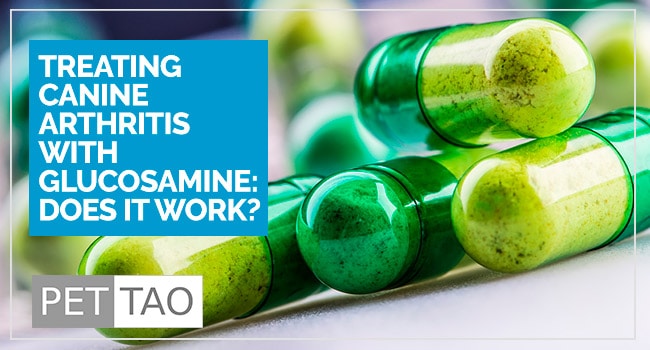As a veterinarian, there is one question I hear every day.
“Can I give my dog glucosamine?”
Yes!
In fact, glucosamine affects a dog’s body the exact same way it affects a person’s body.
In both a dog and person, glucosamine is found in healthy joint fluid and cartilage. When joint fluid is degraded by injury or wear and tear, a glucosamine supplement can help restore the damaged fluid and tissue.
And surprisingly, it is even safe for dogs to take human glucosamine supplements.
Glucosamine for dog arthritis is like clothes for an Eskimo or water for a fireman.
Why?
Because glucosamine is frequently used as a“first line” dog arthritis treatment.
You can buy glucosamine at any drugstore, or even Wal-Mart.
It is sold everywhere and is a common home remedy for arthritis treatment.
What kind of glucosamine should I give my dog?
Companies market many brands of dog glucosamine all with pretty packaging and with the promise of providing relief of your dog’s arthritis symptoms.
Most of these products contain the same active ingredients – glucosamine and chondroitin – and are frequently mixed with other ingredients including Yucca, avocado, devil’s claw, and other phytopharmaceuticals.
Oral formulations of glucosamine-chondroitin come with contradictory scientific support.
Some studies support its use while others claim no benefit.
However, many veterinarians recommend these products to treat arthritis.
Whether or not you use glucosamine in your dog is really a personal choice.
What is the dosage of glucosamine for dog arthritis?
It depends on whether or not the product is oral or injectable.
Yes, glucosamine is available in both oral and injectable preparations.
Oral Glucosamine
- Dosage: Oral dosage is 500-1000 mg per 25 lbs of dog daily, depending on the clinical condition of your dog (you need to read the product label to make sure the appropriate dose for your dog is in the supplement).
- Pros
-
- Inexpensive
- Easy to obtain
- Easy to give at home
- Stimulates the cartilage to produce collagen
- Can be used by the body to produce hyaluronic acid in synovial fluid
- May reduce the need for NSAIDs.
- Cons
-
- Does not work as quickly as injectable glucosamine
- Does not work as effectively as injectable glucosamine
- Many dogs do not like to take oral glucosamine.
Injectable Glucosamine
- Dosage: The dosage for injectable glucosamine is usually 0.02 mg per pound of body weight. First, you must use a loading dose protocol of one injection every 4 days for a total of 8 injections. Then, after the loading dose has been completed, you must re-inject every 2-4 weeks. (This protocol is my recommendation based on years of experience using this medication and may vary from what some other veterinarians might recommend.)
- Pros
- Reaches the joint within 2 hours
- Supports the cartilage matrix repair process
- Diminishes joint and joint fluid damage
- Slows the disease cycle of non-infectious arthritis
- Reduces inflammation
- Works much more rapidly and effectively than oral glucosamine
- Stimulates the cartilage to produce collagen
- The body uses it to produce the hyaluronic acid in synovial fluid
- May reduce the need for NSAIDs.
- Cons
- Being an intramuscular injection, this product requires multiple trips to the vet clinic or the owner must learn how to give an intramuscular injection.
- Many dogs despise getting injections and will try to bite.
- Injectable glucosamine costs much more than oral glucosamine.
Proactive Ways to Help Your Dog’s Arthritis
There are many quick and easy things you can do at home to give your dog an edge on arthritis challenges.
- Learn more about dog arthritis.
- Try cooking for your dog or feeding high-quality dog food. Home-cooked diets and wet food help keep your pet from gaining too much weight. In turn, less weight means less stress on your dog’s bones and joints. PET | TAO Chill and Blaze are top choices for arthritic dogs.
- Ease your dog’s discomfort naturally. PET | TAO Comfort is a blend of Eastern herbs and Western supplements to soothe your dog’s arthritic challenges to make him/her more comfortable.
- Provide joint support. PET | TAO Harmonize Joint is a blend of Eastern herbs and Western supplements working together to lubricate and restore your dog’s joints.
- Try Freeze-Dried Kidney Treats. According to TCVM, the Kidney controls the bones and joints and supports arthritic challenges in a “like treats like” manner.
- Learn more about TCVM Herbal Remedies. Chinese medicine offers many amazing natural solutions for dog arthritis. Some good examples are:
Get A Phone Consultation with One of Our TCVM Veterinarians








